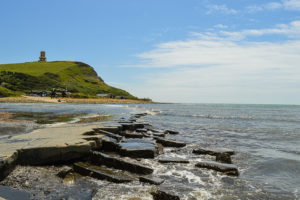 Highcliffe was a town that used to be in the county of Hampshire but is now the most easterly parish in Dorset. It is a bustling little coastal town that is located to the south west of the New Forest National Park which is only a short drive away.
Highcliffe was a town that used to be in the county of Hampshire but is now the most easterly parish in Dorset. It is a bustling little coastal town that is located to the south west of the New Forest National Park which is only a short drive away.
A short steep cliff falls down to Highcliffe beach and there are super coastal views across the sea to the Isle of Wight and the Needles. To the west, Hengitsbury Head and the popular beach resort of Bournemouth can be seen on the horizon.
The town of Highcliffe is constructed of houses that are set back in well wooded surroundings. It has a High Street that runs parallel to the sea. Its main claim to fame, Highcliffe Castle is a very popular attraction that brings in much needed revenue to the town and just happened to be the residence of Mr Selfridge himself, owner and founder of the big department store in London.
Classed as a rather odd but attractive building by some, Highcliffe Castle was built in the 1830s in the Romantic Gothic style. The castle was made more elaborate by the addition of real late Gothic French features, such as the very ornate oriel window above the porch and the windows to the right of it. By the road the hall can be seen and this appears to resemble a church. After extensive fire damage in the 1960s, thankfully the Castle or house as it is otherwise known, has been restored to its former glory. A scenic little park around the house is open to the public and there is direct access to the beach from the castle car park which is pay & display. Beware the steep steps leading from the car park to the beach.
The church of St. Mark, which is in Hinton Wood Avenue was predominantly built in 1843 and was paid for by the owner of Highcliffe Castle. However, it is largely a plain structure and lacks the character to which the castle was built.

Things To See And Do In Highcliffe
- A stroll along the cliff top or along the beach is recommended and perhaps stop for tea at Highcliffe Castle with its delightful tea rooms. Highcliffe Castle is Open Daily from 1st February to 23rd December. Telephone 01425 278807.
- Highcliffe Castle is a Grade I listed building which was built between 1831 and 1835 by Lord Stuart de Rothesay. It has been described as “the most important remaining example of the Romantic and Picturesque style of architecture.”
- Highcliffe Sailing Club is lucky to be located at the excellent coastal location of Mudeford Quay. Here it permits the club to offer sailing in both the sheltered waters of Christchurch harbour and also the opportunity for open water sailing in Christchurch Bay. Where it is situated makes it the perfect club for sailors with all aspirations and abilities. Mudeford Quay can be found on the east side of the entrance to Christchurch harbour, which is between the historic town of Christchurch to the West. To the east lies Highcliffe and the New Forest.
- The beach between Highcliffe and Mudeford is known to be popular with visitors as it is fairly sandy and safe to swim. There are also beach huts and two cafes that provide food and drink for the walker or beach goer.
- A popular pastime that takes place at Mudeford Quay is crabbing and it often proves a hit with young families who compete to fill their buckets with their day`s catch.
- Take the little ferry across from Mudeford Quay to Hengisbury Head. Take a walk around the stunning headland or admire the beach huts that stand on the spit. You wouldn`t believe how much these cost to buy! Take the little land train across the headland if walking isn`t your thing and be amazed at the fantastic views up the coastline or over to Christchurch Harbour. There is also a cafe/restaurant near the ferry stop for welcome refreshments.

History Of Highcliffe
The history of Highcliffe starts with John, third Earl of Bute, a well-known minister of George III. who bought the estate. The site of the house he had built was said by the present owner of the property, to now be two miles out to sea! This is based on the evidence he gave before the Royal Commission on Coastal Erosion some years ago. The rapid advances of the sea were a constant problem to Lord Bute, the cliff`s continual erosion went on at such a rate that the people who lived on the estate were reluctant to inform him about it.
The path which ran along the top of the cliffs was always disappearing and in order to keep him oblivious to it, the men employed on the estate were kept on standby when he visited his house. They were instructed to make a new path at the cliff edge in case he should happen to walk that way and so not suspect the path was in fact a new one.
Highcliffe was bequeathed to his fourth son, Charles, who found the expense and annoyance of the landslips so intolerable that he sold the estate to a Mr. Penleaze.
Find out more about Highcliffe Castle here.
